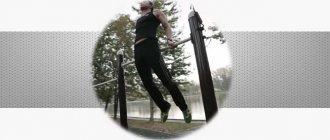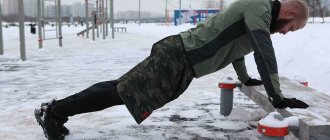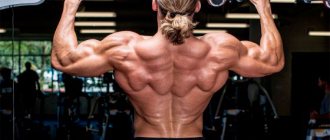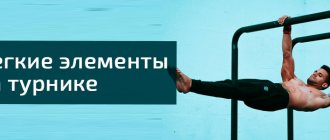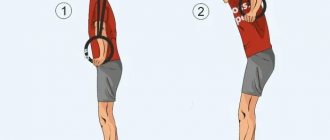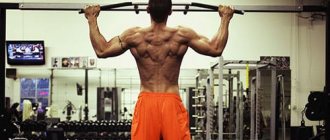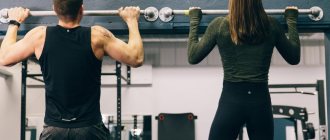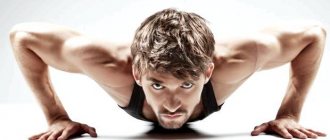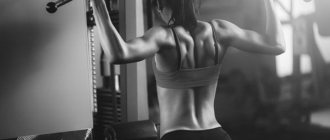Share:
What you need
- Horizontal bar or rings
Exit on the horizontal bar (exit with force on two arms) is a ubiquitous exercise that is basic in artistic gymnastics, workout and crossfit. From artistic gymnastics, the exercise migrated to the army physical training program, from the army to the streets, where it successfully took root in such a newfangled sports discipline as workout. Today we will tell you how to learn how to do exits on the horizontal bar and on rings.
With CrossFit, things are a little more confusing. Due to the fact that CrossFit is a sport for creative people who manage their own training process, performing a two-arm push-up can be used for different purposes and be of a different nature (perform as part of a complex, perform the maximum number of repetitions for a while, perform as a general strengthening exercise, etc.). The basic version of performing a muscle-up involves performing the movement on the crossbar, while the more advanced version involves performing the movement on gymnastic rings. Today we will try to learn both.
Why should you do it?
Exit with two hands is necessary for training the vestibular apparatus. To do it correctly, you need to clearly coordinate several joints and muscles, as well as monitor the trajectory of movement. If you want to become more confident with your balance, then going strong is the first step.
Equally important is the development of muscle flexibility and elasticity. During the movement, you not only rise and fall with the weight, but also make a smooth transition from one position to another. This increases muscle elasticity and elastic properties of joints.
Shoulder joints, elbows, small joints of the hands, forearms - all of them alternately and jointly participate in the release of force.
Muscle strength will also not be left behind. The exercise puts stress on:
- biceps or biceps muscle: involved in tightening the body;
- triceps or triceps: responsible for delay at the top point;
- deltoid muscle: helps with up and down movement;
- small muscles of the hand and forearm: participate in the power jerk;
- abdominal muscles: help fix the legs;
- pectoralis major and minor muscles: hold the body at the top along with the triceps.
This combination of dynamic and static loads and working with your own weight most physiologically (naturally) forms the beautiful appearance of your body. Exercising with two arms will help tighten and strengthen the muscles of the back, arms and chest without harm to health.
Hard work will ensure success
Pulling up to the neck is clearly not enough to complete the exercise; you will need to relearn to learn how to perform the element efficiently. With a high pull-up, the technique is completely different; additional muscles are involved. The undoubted benefits of the exercise are obvious, since you can develop harmonious muscles.
If you master pull-ups to the bottom of your chest, then at first the lifts will not be particularly beautiful; it will take quite a lot of time to perfect the exercise. The second option, performing a pull-up to the navel, will ensure quick success in exiting. But it will take much longer to master it. You need to look for a reasonable compromise if you want to quickly master the exit.
Where to begin
This exercise should be done with appropriate physical preparation. If you have just started training, then you should wait a little before doing two-arm strength training. Because if you cannot do pull-ups or push-ups more than ten times, you will experience excessive stress and simply tear your back or strain your muscles at best. To prepare for this exercise, you can use the following exercises:
- pull-ups with a wide and narrow grip : clasp the horizontal bar with your palms shoulder-width apart (narrow grip) or wider, tilt your body back, you can cross your legs, retract your hips and pull your body, squeezing the muscles between your shoulder blades, first to the level of the horizontal bar, and then higher, in the gym for There are special settings for this, where you can start with pulling up a small weight, start with 1-2 pull-ups, each time increasing by 1-2 until maximum fatigue, the best result before going strong will be 20-30 times in one approach;
- push-ups : push-ups are no less useful than pull-ups, you need to place your hands slightly wider than your shoulders, bring your feet together and straighten your body above the ground, you should lower yourself with your elbows apart - you will feel a feeling of tension in your chest, start with 5-10 push-ups, useful for beginners do the female push-up technique with emphasis on crossed knees or another way;
- push-ups on the top of the bar : this exercise trains one of the phases of power output, you need to climb onto the bar and slightly tilt your body forward, turn your palms, and then lower yourself to the horizontal bar and rise to the top point, this exercise is suitable for more advanced users;
- explosive pull-ups : an option for skilled athletes, performed in a similar technique to regular pull-ups, but the speed is different - here you need to rise up as quickly as possible, with a jerk, the emphasis should be on the speed of execution, and not on the quantity.
After you feel the strength in the muscles of the chest and shoulders, you can proceed to the next step - a two-arm muscle-up.
Medium underhand grip
It is a simpler and easier to perform variation compared to the top one. This is due to the fact that the main part of the load is received by the biceps. Unlike the back, they are initially better suited to pull up. This type of exercise is ideal for beginners who have difficulty with an overhead grip.
The distance between the hands should be the same as when performing pull-ups with a wide overhand grip. The difference is that the palms do not turn away from themselves, but, on the contrary, towards themselves. Performing this exercise is no different in principle from the previous one, but when the shoulders begin to move, they are pulled back and then down. During the entire pull-up, your forearms should remain perpendicular to the floor surface at all times.
Execution technique
Exit by force has three phases of execution:
- Traction. During this period, you need to properly tighten your body to the crossbar or horizontal bar. To begin, place your hands on the bar, shoulder-width apart, with your palms clasping the horizontal bar. Then you need to hang freely, then tilt your body back and your legs forward. The body forms a kind of arc. Feel how your abdominal muscles work. Then, with a sharp tension of the back muscles, you need to “pull” the body towards the crossbar, at least to the level of the solar plexus. At this point, you can balance with your legs and slowly pull your body up and forward.
- Bringing the body over the bar. During this phase, the body needs to be raised higher, the elbows slightly spread to the side and looking back. You need to release your grip a little and turn your palms 90 degrees, then lean forward with your body over the horizontal bar and bring your shoulders forward. You can move on to the last stage.
- Bench press This step is the simplest, you need to straighten your arms and straighten them at the elbow joints. A contraction will be felt in the triceps. Next you need to stay at the top and go down again.
A few tricks to learn faster:
- to avoid the first phase, you can approach the bar and then jump, after which you can move your torso forward and press;
- to improve the result, you can wear weights, preferably on a belt;
- It is useful to balance with your legs - this will support the body and prevent inertia in the first stages of training.
Leading exercises to the exit by force
As already mentioned, this is a complex exercise and is performed in two stages. The first is the pull, and the second element is the push. Thus, the basic leading exercises will be:
- pull-ups (pull-ups), which will have to be performed with a large number of repetitions;
- and the second exercise will be the clean and press, which should be performed from a position above the horizontal bar, and also performed with a high number of repetitions.
- You can also prepare with high pull-ups, in which you need to pull yourself as high as possible from the horizontal bar, aiming for it with your belt, leaving your torso straight.
Current preparatory exercises will be:
- regular pull-ups;
- dips;
- corner or pull-ups with legs extended forward.
pull-ups
- You should also do push-ups;
- Kip-up – This exercise will allow you to develop sufficient momentum on the way out.
Basic mistakes
Unfortunately, such a simple technique often causes errors. Let's break down the most common ones:
- insufficient training: the main mistake is the lack of basic physical training, which significantly complicates both the technique and the safety of the exercise in general;
- a large number of approaches: you should not get carried away, lowering and rising into the third phase more than 10 times, unless you want to practice push-ups on the bar; the point of the exercise is to complete it completely, and not to set a record;
- one-handed exit: a common misconception is that this is useful, on the contrary, it can lead to injury;
- incorrect trajectory of movement in the first phase: often beginners try to move the body parallel to the plane of the horizontal bar, but you need to create an arc, imagine yourself as a stretched bow string, where the base is the horizontal bar;
- lack of rotation of the palms: can lead to excessive stress on the hands, dislocations and sprains;
- incorrect leg movements: trying to swing your body and swing your legs will not lead to correct execution, but bending your knees and pulling them towards your body while lifting will be useful.
Program content
3 workouts per week. Each workout contains 3 blocks of exercises (pulling strength, pressing strength, technical torque). Each block contains 3 exercises. Each one has 3 approaches. Joke. There will be many more approaches. Did you appreciate the joke? Hope so. I'm proud of my sense of humor. And if you haven’t appreciated it yet, then I’ll ask you again after completing the program.
I’ll say right away that between ALL approaches and ALL exercises there should be 2-3 minutes of rest. Otherwise you’ll bore me with these questions in the comments.
What other option is there?
You can try performing a two-arm strength exit from gymnastic rings. However, there are several nuances here. The correct grip of the hands on the rings should be deeper than on the horizontal bar: make sure that the knuckles are in front of the ring, and not above it. This unusual hand position needs to be practiced. For the first approaches, simply hang on the rings in this position for 10 seconds.
The great difficulty of this projectile lies in the need to maintain balance and balance, to a greater extent than on the horizontal bar.
After gripping the ring correctly, you need to bring it slightly narrower than shoulder width and tighten your body. Shoulders should be brought forward. It is important not to let the rings diverge. Then all movements are performed in the same order. When exiting on the rings, your legs should first be bent, and straightened when moving your body forward. This will give an additional push of inertia to movement. To keep the rings from coming apart, you need to press down hard with your hands.
Double-arm power-ups are a useful exercise for developing strength, agility, and balance. First you need to warm up your muscles and practice with pull-ups and push-ups in order to properly develop the muscles of your back and chest. After this, you can begin to exit. And once you get comfortable with the horizontal bar, you can take it one step further and test yourself on the rings. See you soon to discuss a new topic! Subscribe to blog updates and invite friends!
Trick on the horizontal bar “Hatchet” and “Coffin”
With each lesson, the School of Pull-Up Bars, which we already love so much, never ceases to bring joy and smiles to our faces, perfectly arranging the names of the tricks. The next issue will feature two elements on the horizontal bar. Moreover, no matter how you look at it, most likely, after the first trick you will move on to the second. There is nothing comedy-club about the name of the first exercise. By the way, apparently the first trick is a land relative of one of the types of swimming. And its name is “Hatchet”. If this trick hits a person, he will most likely go to the second trick. Then I didn’t have to think long about what to call him... His name is “Grobik”. And so, meet “Hatchet” and “Coffin” performed by Mishka Baratov!
How to prepare for mastering vya in your hands
Let's look at how to learn how to make an exit by force. By the time you start mastering this exercise, you should be able to:
- do pull-ups at least 10-15 times;
- do push-ups on the uneven bars 20-30 times.
Mastering the power-up will be much easier for you if, in addition to/instead of regular pull-ups, you learn how to do high pull-ups.
What are high pull-ups and how to do them?
Regular pull-ups are performed to the level of the neck or upper chest. High pull-ups lift the body above the bar to the level of the diaphragm or waist. When performing them, significantly more muscle groups are involved.
High pull-up technique
How does the technique of performing high pull-ups differ from regular ones:
- the body does not hang vertically - the shoulder girdle is tilted back, the back is arched in the lower back, the legs are pushed forward;
- during the exercise, the elbows do not spread to the sides and do not bend more than 90°;
- the thrust is made in the direction not to the chest, but to the stomach.
When performing high pull-ups, we do not pull our chest up, but, moving our half-bent arms down in an arc, we try to pull our stomach towards the bar. Essentially, this movement is the opposite of a push-up.
To comply with the technique, it is necessary to take the correct starting position, paying attention to the position of the shoulder blades. They should not be pulled outward, as with regular pull-ups, but lowered as far as possible and brought together, as with push-ups.
Extend your arms forward, lower your shoulders and open your chest, pointing your shoulder blades down and inward. We grip without changing the position of the shoulder blades and tilting the shoulder girdle back. In this case, the back bends in the lower back. The crossbar must be grasped with a deep grip so that the large phalanges of the 4 fingers are directed not upward, but forward.
From hanging in this position, we try to pull the stomach towards the bar with an arched movement of the arms downwards. The elbows should not diverge to the sides and bend more than 90°. This movement is reminiscent of the “pullover” exercise - pulling a block down, only the horizontal bar serves as the crossbar of the block, and the weight is your own body weight.
It is recommended to master this exercise on a low horizontal bar, supporting one leg. Grab the bar, remembering the correct positioning of the body, shoulder blades and hands, and hang with one leg extended forward and leaning on the bent second. Perform waist rows, helping yourself with your supporting leg. If it doesn’t work out, you can help yourself with both legs at first.
At the highest point, when the bar touches the body, hold for a few seconds and then lower to the hanging position as slowly as possible. These are the so-called negative pull-ups, a very effective exercise that trains all muscle groups involved.
You can also use rubber loops during training. They will offset some of your weight, making it easier to pull up.
How to train
Do strength exercises every other day. The training should begin with joint exercises to warm up the joints. Then perform in 3-4 approaches:
- bar;
- pushups;
- dips;
- high pull-ups;
- corner - hanging straight leg raise.
If the exercises are not yet possible, do easier versions. Number of repetitions – until muscle failure.
With proper nutrition (2 g of animal protein per kg of body weight) and regular exercise, you will quickly notice progress. The number of repetitions will increase, and the exercise options will become more complex. Along the way, your figure will acquire an increasingly beautiful athletic shape. When you can do about 10 high pull-ups and 20 dips, you'll be able to easily master the two-arm push-up.
